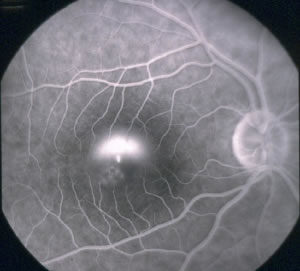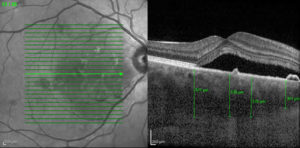Central Serous Chorioretinopathy (CSC)
What is central serous chorioretinopathy (CSC)?
CSC is caused by abnormally leaky blood vessels in a layer behind the retina known as the choroid. Fluid accumulates behind the central part of the retina called the macula. The retina does not function normally with fluid behind it, so the vision becomes blurred.
Who usually gets CSC?
Approximately 9 out of 10 people with CSC are male. Most are relatively young, around 30 or 40 years of age. CSC tends to affect people with “type A” personality; these people are very highly motivated and usually have particularly stressful careers. Less commonly, pregnant women and elderly people may get CSC.
Some environmental factors have been implicated in the cause of CSC:
1) Steroid medications are most commonly associated with this disease. Steroid pills (e.g., prednisone), inhalers, nasal sprays, injections (e.g., for back or knee pain) and even skin creams have been reported in association with CSC.
2) Pseudoephedrine
4) Sleep apnea
3) Helicobacter Pylori (a bacterium that can cause stomach ulcers)
What are the typical symptoms of CSC?
Like many retinal disorders, the vision is usually blurred. CSC can cause unique symptoms in addition to blurred vision. Some people experience distortion. Objects sometimes appear smaller in the eye with CSC than in the unaffected eye (both eyes can be affected, but the disease often causes symptoms in one eye at a time). Color vision can be altered, as well.
Does CSC get better without treatment?
Fortunately, the answer is “yes”. The subretinal fluid usually resolves on its own, with improvement in the vision to a normal or near-normal level. Despite the spontaneous improvement, though, people with CSC usually still notice that the quality of vision in the affected eye is not quite normal. In a minority of cases, the vision does not improve significantly or becomes quite poor.
Can CSC recur?
The good news is that CSC usually gets better on its own, but the bad news is that subretinal fluid recurs in about 50% of cases. Fortunately, it often resolves again. However, some patients experience permanently blurred vision after recurrent episodes.
How is CSC diagnosed?
 The fluid beneath the retina has a specific appearance on examination of the retina. It looks like a “blister” under the retina, located in in or near the central retina. CSC also has a typical appearance on the fluorescein angiogram, where there is often a “pinpoint” spot from which dye leaks. To the right is an image from a fluorescein angiogram showing such a “pinpoint” spot of dye leakage (the white dot and larger white area above it), in the center:
The fluid beneath the retina has a specific appearance on examination of the retina. It looks like a “blister” under the retina, located in in or near the central retina. CSC also has a typical appearance on the fluorescein angiogram, where there is often a “pinpoint” spot from which dye leaks. To the right is an image from a fluorescein angiogram showing such a “pinpoint” spot of dye leakage (the white dot and larger white area above it), in the center:
 Optical coherence tomography (OCT) is helpful in confirming the presence of fluid behind the retina. The image to the left is a nice example. On the left-hand side of this image is a “black and white” photograph of the central retina. The horizontal green lines show where cross-sectional views of the retina have been taken. The brightest green line indicates the cross-sectional view that is shown on the right. The retina is noted to be elevated in the right-hand portion of that image, and the black area below the retina represents fluid that has accumulated beneath the retina. The vertical green lines shown below the retina indicate the thickness of the choroid, a layer of blood vessels beneath the retina. The choroid is quite thickened in this case. Choroidal thickening is typical of CSC, and a thickened choroid on OCT scanning can be a helpful clue in diagnosing this disorder.
Optical coherence tomography (OCT) is helpful in confirming the presence of fluid behind the retina. The image to the left is a nice example. On the left-hand side of this image is a “black and white” photograph of the central retina. The horizontal green lines show where cross-sectional views of the retina have been taken. The brightest green line indicates the cross-sectional view that is shown on the right. The retina is noted to be elevated in the right-hand portion of that image, and the black area below the retina represents fluid that has accumulated beneath the retina. The vertical green lines shown below the retina indicate the thickness of the choroid, a layer of blood vessels beneath the retina. The choroid is quite thickened in this case. Choroidal thickening is typical of CSC, and a thickened choroid on OCT scanning can be a helpful clue in diagnosing this disorder.
How is CSC treated?
Most retina specialists prefer not to treat CSC if possible. There are, however, situations in which retina specialists would recommend treatment. In cases where the leakage is far from the center of the retina, CSC is sometimes treated by placing just a few very light laser burns in the area of the leakage. Laser treatment often stops the leakage, resulting in resolution of the fluid beneath the retina and improvement of the vision. If the leakage is close to the center of the retina, if the area of leakage is diffuse rather than focal, and/or if leakage persists despite laser treatment, photodynamic therapy is sometimes used. Any visual improvement usually occurs gradually after treatment, over weeks to months.
Other treatments, in pill form, have been suggested as alternatives in cases of persistent subretinal fluid despite laser and/or photodynamic therapy. These treatment options have not been proven to be effective, but some patients who have been resistant to more standard therapies have responded to them. Proposed alternative treatments for CSC include medications such as rifampin and mifepristone.


